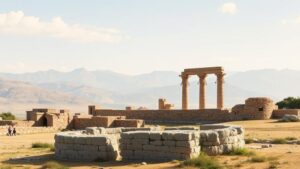Following ancient pilgrim trails to discover forgotten monasteries.
Following Ancient Pilgrim Trails to Discover Forgotten Monasteries
Embarking on a journey along ancient pilgrim trails offers not just a physical adventure but an exploration into history, spirituality, and architecture. Ancient monasteries, often nestled in remote landscapes, tell stories of devotion and perseverance. This article delves into several notable pilgrim routes, the forgotten monasteries they unveil, and the spiritual journeys they offer to modern explorers.
The Significance of Pilgrim Trails
Pilgrim trails were significant routes traveled by those seeking spiritual renewal, adventure, or penitence. Many of these pathways emerged in the Middle Ages, serving as arteries of faith connecting towns, cities, and sacred sites. As millions wandered these paths, they not only sought solace but also facilitated trade and culture, helping to shape the regions they traversed.
Notable Pilgrim Trails
- The Camino de Santiago: This trail, leading to Santiago de Compostela in Spain, has been a significant pilgrimage since at least the 9th century. Thousands of pilgrims traverse its various routes each year.
- The Via Francigena: Stretching from England to Vatican City, this pilgrimage path gained prominence in the 11th century. It offers insights into medieval architecture and ecclesiastical history.
- The Pilgrimage of Thomas Becket: After the martyrdom of Archbishop Thomas Becket in 1170, many began to visit Canterbury, following trails that reveal the rich tapestry of medieval England.
Discovering Forgotten Monasteries
As these routes wind through picturesque landscapes, they often lead to lesser-known but architecturally stunning monasteries, many of which have been left largely forgotten. For example, the Monastery of Santa María la Real de Irache, located along the Camino de Santiago in Spain, dates back to the 11th century. Once a vibrant community, it is now a peaceful retreat for modern pilgrims seeking reflection.
Another remarkable example is the Abbey of Fountains in North Yorkshire, England. Founded in 1132, it was one of the first Cistercian monasteries in the country. Visitors today can explore its impressive ruins and gardens, gaining insight into monastic life.
Historical Context and Preservation Efforts
Throughout history, various factors have contributed to the abandonment or neglect of these monasteries. The Reformation, the dissolution of monasteries, and changing social structures often left these sacred spaces in ruins. Today, groups like Heritage Lottery Fund in the UK and similar organizations in Europe are actively working to restore and maintain these historical sites.
Real-World Applications: Spiritual and Cultural Journeys
Walking these ancient trails not only serves as a physical journey but also fosters spiritual growth. Modern pilgrims often reflect on their life’s purpose while traversing these historical paths. Also, eco-tourism opportunities abound, as local economies benefit from the influx of hikers and spiritual seekers.
Potential Challenges
While these journeys are enriching, potential challenges exist. Pilgrims should be aware of:
- Physical demands of long-distance walking
- Possible language barriers in remote locations
- Variable weather conditions affecting travel
Proper planning, including physical preparation and research, can mitigate these challenges, ensuring an enjoyable experience that connects them with history, spirituality, and community.
Actionable Takeaways
For those looking to embark on a pilgrimage in search of forgotten monasteries, consider the following:
- Research historical trails and determine which monastery sites resonate with your spiritual or cultural interests.
- Plan your route and accommodations ahead of time, focusing on local resources that support preservation efforts.
- Engage with local guides or groups who can provide depth to your experience through shared knowledge and insight.
Following ancient pilgrim trails leads to more than just a physical destination; it offers a window into history and a path to personal discovery. These journeys are an invitation to connect with the past while exploring the beauty and serenity that these forgotten monasteries still hold.


